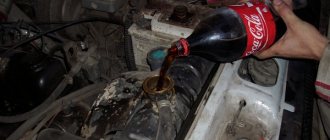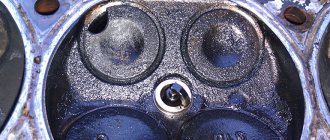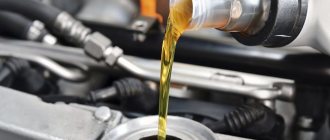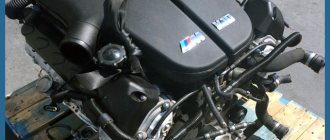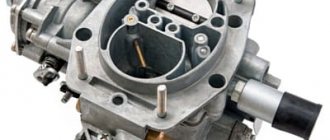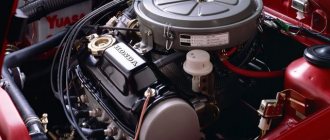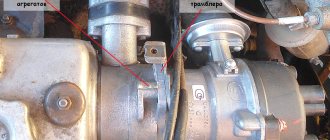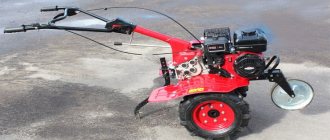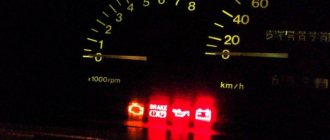Work principles
An injector is a system that is regulated by an electronic control unit. It injects fuel into the combustion chamber through injectors. The injector allows you to precisely control the dose of gasoline, which is why it is used in most modern cars.
Carburetors have been used since the very beginning of automobile manufacturing. The fuel is mixed with air inside its housing, and then it is sucked under pressure into the intake manifold.
The carburetor does not have sensors that react to the number of revolutions. Because of this, equal doses of fuel constantly enter the combustion chamber. Gasoline consumption is uneven and you have to refuel frequently. And exhaust gases are quite toxic; they pollute the atmosphere.
The injector does not have such disadvantages, since it supplies gasoline into the chamber taking into account the speed. Thanks to this precision, the emission of harmful substances during fuel combustion is reduced.
The design and principle of operation of the carburetor
Carburetor operation diagram
The fundamental differences between a carburetor and an injector lie in the method of supplying the combustible mixture to the combustion chambers and the design of the ignition system.
The figure shows the most simplified diagram of a carburetor. However, with its help it is quite possible to understand how the air-fuel mixture is supplied to the cylinders. Let us briefly describe how such a device works. The carburetor is mounted on the intake manifold (lower plane), and the air filter is installed on top (upper plane). Gasoline is supplied by the fuel pump through inlet 1. To maintain the required fuel level in the float chamber of the carburetor 11, the inlet is equipped with a needle valve 2. Upon reaching a certain level, the float rises and, through a small lever, presses on the valve, closing it. Fuel and air, under the influence of the vacuum created by the piston as it moves down (with the cylinder inlet valve open), rush through the intake manifold into the engine cylinder. To improve the mixing of fuel with air and to make the mixture more dense, the cross-section of the chamber in the lower part of the carburetor has the shape of a cone - this is the simplest diffuser. The supply of the fuel mixture is regulated by throttle valve 7, the axis of which is connected (using rods or a cable) to the gas pedal, and the amount of air in the combustible mixture is regulated by a throttle sensor . The amount of gasoline coming from the float chamber is determined by the diameter of the fuel nozzle 9. To start a cold engine, a richer mixture is required, that is, the air/gasoline mixture ratio should have a lower value. To do this, an air damper 5 is installed in the upper part of the carburetor. When it is closed (with a small gap), the amount of air participating in the formation of the combustible mixture is significantly limited, and it becomes enriched, which makes it easier to start the engine. After the engine warms up, the air damper opens. Manipulation is carried out manually - with a special cable, the handle of which is installed in the car interior.
We recommend: 8 best timing belts
Solex carburetors
Solex carburetor operation diagram
A two-chamber carburetor has a number of parts that help supply the fuel mixture to the combustion chamber under various operating conditions.
Unlike the simplest ones, carburetors installed on cars have a more complex design. Let us consider, again, only in general terms, the design of carburetors of the Solex family, which were equipped with the VAZ 2108 - 99, VAZ 21213 Taiga (which is an updated Niva VAZ 2121), the first models of the VAZ 2110. Photos above show the appearance , below is an image that is not a cross-sectional drawing of a node, but represents a schematic drawing, that is, in some way a development. A carburetor, unlike the simplest one, has a number of parts that help supply the fuel mixture to a real engine in various operating modes. The device already has two chambers (l and ll), each with a throttle valve, and only the first chamber is equipped with an air damper. The second chamber begins to work after the first one opens halfway, that is, when driving at high speeds. In addition, the device is equipped with an idle system and a hose fitting through which excess fuel flows into the tank. Unlike the schematic one, the carburetor also has:
- not only fuel (39 and 29), but also air jets (14 and 7);
- adjustable idle system;
- air damper control system. That is, the damper closes and opens manually, using a cable, but its position is adjusted by the diaphragm 3 of the trigger;
- accelerator pump - to enrich the mixture during acceleration by injecting an additional portion into the chambers. Its diaphragm 42 is driven by lever 42. Gasoline is supplied through channels to the sprayer 11.
However, a detailed description is now completely unnecessary. The purpose of the material is to show the differences between an injector and a carburetor. From what is said above, the following conclusions can be drawn:
- To supply the mixture, the vacuum created by the engine pistons is used; its composition is determined by the diameter of the nozzle holes.
- All actuators, including the fuel pump , are mechanically driven, with the exception of the forced idle solenoid valve 5.
Advantages of a carburetor
To understand the difference between an injector and a carburetor, you need to understand the advantages of each system. The main advantage of carburetor engines is simple maintenance.
To get started, the driver must read the small manual and configure the system only once. Then it will function according to the first instructions. There are practically no malfunctions in the operation of carburetor engines.
But even if they break down, they can be easily repaired. No special tools are needed for this. All you need is a few wrenches and a screwdriver. There is no need to contact a service station - the driver can do the repairs himself in his garage.
The carburetor is suitable for using low-quality gasoline and diesel. It does not show particular sensitivity to foreign impurities. The jets clog quickly, but they are easy to clean - you can simply blow them out. Engine performance changes quickly in cars with a carburetor. Therefore, you can drive off-road, make sharp turns and overcome steep climbs or descents.
But this system also has several disadvantages:
toxic exhausts;
high fuel consumption;
sensitivity to temperature.
The carburetor responds to atmospheric pressure and ambient temperature. Since it accepts fuel with impurities, the burned particles turn into toxic gases. Due to the same supply, gasoline is consumed unevenly.
CARBURETOR
It was invented first, its exaggerated modifications were still at the dawn of internal combustion engines, so it can be called the grandfather of modern engine power systems.
A device in the power supply system of carburetor internal combustion engines, designed for mixing (carburetion, from the French - carburation) gasoline and air, creating a combustible mixture and regulating its flow.
What did such a system consist of (for example, I’ll take the VAZ 2101):
- Tank (fuel storage)
- The float and together with it the gasoline injection tube. The float monitored the fuel level and showed it on the instrument panel
- Fuel line. Usually these are gas-resistant hoses and tubes (copper, aluminum)
- Fuel pump (diaphragm type). Pumped with a pressure of 20 - 30 kPa (about 0.3 atmospheres). Usually located in the engine compartment, and was attached to the engine. Why? Yes, simply because it was driven mechanically - by an eccentric drive of the oil pump and ignition distributor through a pusher. If you exaggerate, there is a special “lever” inside the pump, on which this eccentric pressed and fuel was pumped due to the vibration of the membrane. By the way, there was also a lever on the outside of the case for manual pumping, for example - if you ran out of fuel, filled it with new fuel, and you had to pump it manually in order to start the car and not waste the battery charge.
- Carburetor. From the pump there was a hose with fuel, which approached the main unit. It was the carburetor that mixed fuel on one side and captured air on the other. By the way, there was usually a round jar on top in which there was an air filter through which air passed and entered inside for mixing.
- Intake manifold. Already through it the finished fuel-air mixture entered the engine cylinders.
Advantages of the injector
The advantages of the electronic system also make it possible to understand the difference between an injector and a carburetor. The power of injection engines is much higher than carburetor engines.
The system can precisely set the ignition angle, and gasoline injections will be dosed depending on the number of revolutions. The injector can work stably only with high-quality fuel. Thanks to this, fewer toxic substances enter the atmosphere.
The engine does not need to be warmed up in winter, as it does not freeze. Such a system does not respond to atmospheric pressure and ambient temperature. It is easy to control the injector - there is an ECU for this. And all information about its operation is displayed on special sensors. The system does not have distributors, like carburetors. And in the latter type of engines, they are the ones that break down most often.
Injectors also have their drawbacks:
complex diagnostics;
fuel sensitivity;
high cost of repairs and parts.
An electronic engine allows you to increase the power of the car, but if it breaks down, you will have to take the car to a service station for diagnosis and repair. And this will cost a lot - spare parts for injectors are quite expensive. It will not be possible to use cheap low-quality fuel in such a system. Because of it, the injectors quickly become clogged, and the injector itself may break.
Composition of the injection system
The engine fuel injection system is technically more advanced and reliable. But the presence of a larger number of components, their complexity and dependence on each other, complicate diagnostics and independent repairs, especially on the road.
It includes:
- electric fuel pump;
- distribution ramp;
- injectors (nozzles);
- electronic control unit;
- a group of sensors (throttle position, lambda probe, air flow, detonation).
The electronic injection control unit on VAZ cars also uses signals from sensors that are also present on a carburetor engine, for example, temperature, hall, etc. It’s just that in an engine with a carburetor, the functionality of these devices is no longer related to the fuel supply.
Main differences
The main difference between a carburetor and an injector is the operating principle. In the first case, gasoline is sucked into the cylinder, and in the second it is injected through nozzles into the combustion chamber. But it is not only this:
efficiency;
environmental friendliness;
cost of maintenance and repairs;
Sensitivity to climate and fuel.
An injector is much more economical and environmentally friendly than a carburetor. It allows you to use less fuel and practically does not pollute the air when releasing gases. The frequency of breakdowns also differs. The carburetor will have to be repaired much more often. Although its maintenance will be cheaper than simple injector diagnostics.
The two systems exhibit different sensitivity to ambient temperature. The carburetor freezes if you leave your car outside in winter. A fuel-injected car does not need to be warmed up.
The quality of the fuel also depends on the type of engine. In a carburetor, you can use cheap gasoline with impurities, the injector will not withstand this. He needs high quality fuel.
CARBURETOR
It was invented first, its exaggerated modifications were still at the dawn of internal combustion engines, so it can be called the grandfather of modern engine power systems.
A device in the power supply system of carburetor internal combustion engines, designed for mixing (carburetion, from the French - carburation) gasoline and air, creating a combustible mixture and regulating its flow.
What did such a system consist of (for example, I’ll take the VAZ 2101):
- Tank (fuel storage)
- The float and together with it the gasoline injection tube. The float monitored the fuel level and showed it on the instrument panel
- Fuel line. Usually these are gas-resistant hoses and tubes (copper, aluminum)
- Fuel pump (diaphragm type). Pumped with a pressure of 20 - 30 kPa (about 0.3 atmospheres). Usually located in the engine compartment, and was attached to the engine. Why? Yes, simply because it was driven mechanically - by an eccentric drive of the oil pump and ignition distributor through a pusher. If you exaggerate, there is a special “lever” inside the pump, on which this eccentric pressed and fuel was pumped due to the vibration of the membrane. By the way, there was also a lever on the outside of the case for manual pumping, for example - if you ran out of fuel, filled it with new fuel, and you had to pump it manually in order to start the car and not waste the battery charge.
- Carburetor. From the pump there was a hose with fuel, which approached the main unit. It was the carburetor that mixed fuel on one side and captured air on the other. By the way, there was usually a round jar on top in which there was an air filter through which air passed and entered inside for mixing.
- Intake manifold. Already through it the finished fuel-air mixture entered the engine cylinders.
Nuances of injector diagnostics
The difficulty of diagnosing a VAZ injection system lies in the fact that its operation is affected by all components and it is not so easy to understand what exactly is malfunctioning:
- nozzle;
- any sensor;
- pressure regulator;
- Control block.
The catch may lie in the fuel pump: the mere presence of fuel in the rail is not a sufficient condition for the injector to operate - it is necessary that the pump provide a certain performance and pressure. Check the indicated indicators using a volumetric flask and a pressure gauge.
Unlike a carburetor, the quality of operation of the injection system is influenced by the condition of the vehicle's electrical wiring. Oxidized wiring connectors and sensors can cause failures. And if instead of 12V only 8V reaches the terminals of the electric pump, then there can be no talk of any of its performance, and therefore normal operation of the engine.
